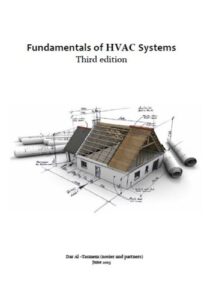Fundamentals of HVAC Systems Third edition Dar Al-Tasmem
Fundamentals of HVAC Systems Third edition Dar Al-Tasmem
In this course Fundamentals of HVAC Systems Third edition, We will start By defining The term “air conditioning” has gradually changed, from meaning just cooling, to the Total control of:
- Temperature
- Moisture in the air (humidity)
- Supply of outside air for ventilation
- Filtration of airborne particles
- Air movement in the occupied space.
Air is made up of five main gases i.e. Nitrogen 78.03%, Oxygen 20.99%, Argon 0.94%, Carbon Dioxide 0.03%, and Hydrogen 0.01% by volume. The Ideal Gas Laws are used to determine psychometric data for air so that the engineer can carry out calculations. To make life easier a chart compiled with all the relevant psychometric data indicated. This is called the Psychometric Chart
Air at any state point can be plotted on the psychometric chart. The information that can be obtained from a Psychometric Chart is as follows:
- Dry bulb temperature
- Wet bulb temperature
- Moisture content
- Percentage of saturation
- Specific enthalpy
- Specific volume.
You can also read HVAC Training summery – Dar El Handasah
Fundamentals of HVAC Systems Third edition Course Content
- Chapter 1- HVAC Systems Basic Information
![Fundamentals of HVAC Systems]()
Introduction
Air properties.
Air Conditioning process.
Basic Air-Conditioning Systems.
How the human body interact with the environmental.
Environments for Human Comfort.
Scope of Modern HVAC
- Chapter 2 –load estimation
Hourly Analysis Program (HAP).
- Chapter 3-system selection and air distribution
System Choice.
System Performance Requirements.
Decision Factors for Choosing Units.
DX Refrigeration Equipment.
Air Distribution Systems.
Supply and return air system layout.
- Chapter4-Ventilation Systems
Introduction.
Purposes of Ventilation.
Ventilation Calculations.
Ventilation Systems.
Mechanical ventilation equipment.
Ventilation design Methodology.
- Chapter 1- HVAC Systems Basic Information Contents
Introduction
Air properties.
Air Conditioning process.
Basic Air-Conditioning Systems.
How the human body interact with the environmental.
Environments for Human Comfort.
Scope of Modern HVAC
The cooling load for a space made up of many components, including: Conduction heat gain from outdoors through the roof, exterior walls, skylights, and windows. (This includes the effects of the sun shining on these exterior surfaces.)
Downoad
Fundamentals of HVAC Systems Third edition Dar Al-Tasmem
2nd Link Here


Comments are closed.